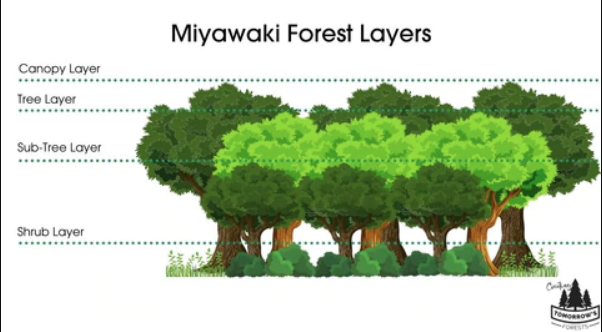The Miyawaki method: creating dense forests
Japanese botanist Akira Miyawaki endowed the Miyawaki Method to create dense forests with native plants. This unique method is used worldwide for urban afforestation by growing a forest in someone’s backyard.

Requirements for Afforestation through the Miyawaki Method
- The Miyawaki afforestation method requires quite a small space, at least 20 square feet.
- One must seed plants very close to save space and dense plant growth. This will also allow young trees to protect each other and block sunlight from hitting the forest’s ground, preventing parasitic plant growth.
- This process must attain plant growth 10 times faster, and vegetation 30 times denser than usual.
- One must maintain such a forest for at least 3 years, according to the Miyawaki method.
Also Read: How to Enhance Immune System The Ayurvedic Way
Process of Afforestation through Miyawaki Method
An Indian pioneer and expert of afforestation, Shubhendu Sharma, explained everything one needs to learn about the Miyawaki method. He also unveils every step of afforestation under this method, which are as follows:
Step 1: Examine the Soil Texture and Measure Biomass
- Examining soil texture is essential as it helps determine fertility, water retention, percolation, etc. All these elements determine the growth and longevity of the forest.
- Then one must measure the existing biomass of the soil. An afforest can add the following biomass to prepare the earth:
:max_bytes(150000):strip_icc()/healthy-soil-and-how-to-make-it-2539853-hero-fdf9b0280dca41cb8ae9614e6fc4a0b0.jpg)
-
- Organic fertilisers- The ground requires fertiliser to provide nutrients for plant growth. Some organic fertilisers are cowpat, goat muck and vermicompost.
- Perforating materials- These materials are helpful for plants to penetrate their roots deeper into the ground. Rice husk, wheat husk, or groundnut shells can be an excellent resource to increase perforation.
- Water retainers- A ground must have significant water retention power to develop a forest. An afforest can add coconut coir and peat moss to strengthen the soil’s water retention power.
- Mulch- It is usually layered over the ground to protect it from the scorching sun. It is vital, especially for saplings, as their growth may be affected in dried soil. Afforests can use decaying leaves, dried bark, or even composts.
Step 2: Select Native Species for Plantation
- Afforests must select the native plant species and identify their genus (deciduous or evergreen), height and influence on nature.
- Foresters must allocate those plants in layers, depending on all the above factors.
- 40 to 50 per cent of the total number of trees must comprise the most commonly found species in one’s neighbourhood. Foresters must choose at least 5 different genera that would be the significant species in that forest.
- Some moderately found native species will compose 25 to 40 per cent as supporting plants. Finally, some other minor species will constitute the rest of the forest.
- Afforests need to collect saplings of these species, which must be in a minimum height of 60 to 80 cm.

Step 3: Prepare the Ground and Equip the Forest Area
- Before starting the planting process, afforests must inspect the ground to determine the possibilities and practicality of this project.
- The soil of this area must be clean from any debris and weed.
- It also must catch sunlight for at least 8-9 hours a day to start afforestation under the Miyawaki method.
- Foresters must install irrigation facilities, create 100 sq metre mounds and demark those before sowing.
Step 4: Start the Plantation Process
- One should dig small holes in the soil and remove the root bag of the seedlings to plant them.
- He must put these saplings in those holes and lightly level the soil around their stem.
- It is crucial to choose proper supporting sticks for these plants, according to their height.
Step 5: Take Care of the Forest for the Next 3 Years
- Monitoring the forest involves watering it daily, cleaning the weeds and plastics, and maintaining proper drainage.
- Foresters must maintain the mulch level and keep changing it for a minimum of 1 year. They also must have an eye on the plant’s growth to ensure the mulch does not immerse it.
- They must not trim the forest, use chemical pesticides and fertiliser, and clean the shed leaves.
The Miyawaki method has many advantages, including:
- Quick forest growth: Miyawaki forests can grow 10 times faster than other methods.
- Denser forests: Miyawaki forests are 30 times denser than other methods.
- More biodiversity: Miyawaki forests contain 100 times more biodiversity than other methods.
- Low maintenance: Miyawaki forests are maintenance-free after the first two to three years.
- Carbon sequestration: Miyawaki forests increase carbon sequestration.
- Soil nourishment: Miyawaki forests make soil nutritious.
- Habitat for wildlife: Miyawaki forests attract local birds and insects.
- Climate resilience: Miyawaki forests can help cities build climate resilience.
- Reduced pollution: Miyawaki forests help control air, water, noise, and soil pollution.
- Reduced heat islands: Miyawaki forests help lower temperatures in concrete heat islands.
- Cost effective: Miyawaki forests are cost effective.
- Prevents calamities: Miyawaki forests can serve as a natural bulwark against soil erosion and Tsunami.
